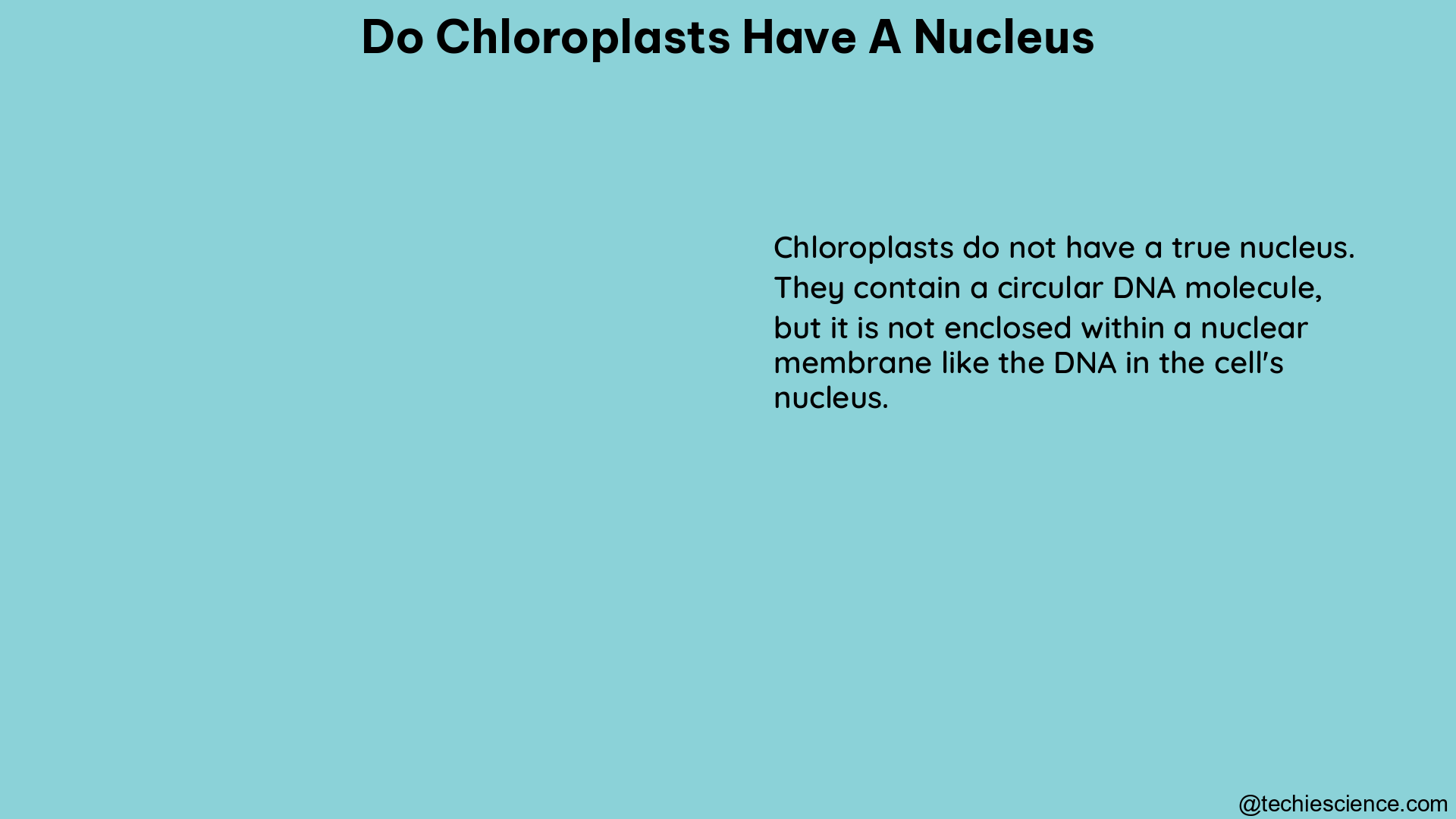Chloroplasts are specialized organelles found in the cells of plants and some algae, responsible for the process of photosynthesis, where light energy is converted into chemical energy in the form of ATP and NADPH. These organelles are known to have their own genetic material, but they do not possess a true nucleus like the one found in the host cell. This unique characteristic of chloroplasts has been a subject of fascination for biologists, as it provides insights into the evolutionary history and the intricate relationship between these organelles and the eukaryotic cells they reside in.
The Endosymbiotic Origin of Chloroplasts
Chloroplasts are believed to have originated from a cyanobacterium-like prokaryotic organism that was engulfed by a eukaryotic host cell through a process known as endosymbiosis. This event is thought to have occurred more than a billion years ago, during the early stages of the evolution of eukaryotic cells.
The evidence for this endosymbiotic origin of chloroplasts includes:
-
Structural Similarities: Chloroplasts share many structural similarities with cyanobacteria, such as the presence of a double-membrane envelope, the organization of the thylakoid membrane system, and the presence of circular DNA.
-
Genetic Similarities: Chloroplast DNA (cpDNA) is similar in size and structure to the genome of cyanobacteria, and it encodes many of the same genes involved in photosynthesis and other essential functions.
-
Protein Targeting: Chloroplasts have specialized mechanisms for importing nuclear-encoded proteins, which is a hallmark of endosymbiotic organelles.
-
Evolutionary Relationships: Phylogenetic analyses have consistently placed chloroplasts as the closest living relatives of cyanobacteria, further supporting the endosymbiotic origin of these organelles.
The Genetic Organization of Chloroplasts

Chloroplasts, unlike the host eukaryotic cell, do not possess a true nucleus. Instead, they contain their own circular DNA molecule, known as the chloroplast genome or plastid DNA (cpDNA). This cpDNA is typically a small, circular molecule, ranging in size from 120 to 200 kilobases (kb) in most plants.
The chloroplast genome encodes a limited number of genes, typically around 100-120 genes, which are primarily involved in the processes of photosynthesis, gene expression, and other essential functions within the chloroplast. However, the majority of the proteins required for chloroplast function are encoded by the nuclear genome of the host cell and are imported into the chloroplast.
The chloroplast genome is organized in a compact manner, with few introns and little non-coding DNA. The genes are often arranged in operons, similar to the organization observed in prokaryotic genomes. This compact organization is thought to be a remnant of the cyanobacterial ancestry of chloroplasts.
Chloroplast Biogenesis and Retrograde Signaling
The biogenesis of chloroplasts, from the initial development of the organelle to its maturation, involves a complex interplay between the chloroplast and the nucleus of the host cell. This process is facilitated by a mechanism known as retrograde signaling, where the chloroplast communicates with the nucleus to coordinate the expression of nuclear-encoded genes involved in chloroplast function.
During chloroplast biogenesis, the incomplete chloroplast and the nucleus engage in a bidirectional communication. The chloroplast provides instructions on gene regulation to the nucleus, while the nucleus supplies the necessary proteins and other components required for the assembly and function of the chloroplast.
In mature chloroplasts, this retrograde signaling continues to play a crucial role in maintaining optimal levels of chloroplast function. The chloroplast’s metabolic status, such as changes in the redox state or the levels of specific metabolites, is communicated to the nucleus. This information is then used to systematically up- or down-regulate the expression of nuclear-encoded photosynthetic genes, ensuring that the chloroplast’s function is coordinated with the overall metabolic needs of the plant cell.
Chloroplast Dynamics and Interorganelle Communication
Chloroplasts are not static organelles; they undergo dynamic changes in response to various environmental and developmental cues. These changes include alterations in size, shape, and number, as well as the regulation of their metabolic activities.
The coordination of these dynamic processes involves complex signaling pathways that facilitate communication between the chloroplast and other organelles within the plant cell, such as the nucleus, mitochondria, and peroxisomes. This interorganelle communication is crucial for the integration of chloroplast function with the overall cellular metabolism and homeostasis.
For example, the perturbation of chloroplast-localized sulfate assimilation has been shown to result in global changes in nuclear gene expression, demonstrating the intricate connections between the chloroplast and the nucleus. Similarly, the redox status of the chloroplast can influence the expression of nuclear-encoded photosynthetic genes, highlighting the dynamic nature of this interorganelle communication.
Conclusion
In summary, chloroplasts are remarkable organelles that play a vital role in the photosynthetic processes of plants and algae. Despite their endosymbiotic origin and the presence of their own genetic material, chloroplasts do not possess a true nucleus like the one found in the host eukaryotic cell. Instead, they rely on a complex system of retrograde signaling and interorganelle communication to coordinate their biogenesis, function, and integration with the overall cellular metabolism. This unique characteristic of chloroplasts provides valuable insights into the evolutionary history and the intricate relationships between organelles within eukaryotic cells.
References:
- Jarvis, P., & López-Juez, E. (2013). Biogenesis and homeostasis of chloroplasts and other plastids. Nature Reviews Molecular Cell Biology, 14(12), 787-802.
- Kleine, T., & Leister, D. (2016). Retrograde signaling: Organelles go networking. Biochimica et Biophysica Acta (BBA)-Bioenergetics, 1857(8), 1313-1325.
- Nott, A., Jung, H. S., Koussevitzky, S., & Chory, J. (2006). Plastid-to-nucleus retrograde signaling. Annual Review of Plant Biology, 57, 739-759.
- Sato, N. (2001). Was the evolution of plastid genetic machinery influenced by nuclear-encoded plastid-targeted proteins?. Plant and Cell Physiology, 42(12), 1303-1309.
- Timmis, J. N., Ayliffe, M. A., Huang, C. Y., & Martin, W. (2004). Endosymbiotic gene transfer: organelle genomes forge eukaryotic chromosomes. Nature Reviews Genetics, 5(2), 123-135.
Hey! I am Sneha Sah, I have completed post graduation in Biotechnology. Science has always been fascinating to me and writing is my passion. As an academic writer my aim is to make Science easy and simple to learn and read.